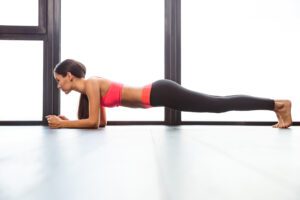In the vast landscape of core exercises, two powerhouses stand out: the classic push-up and the static plank. Each of these exercises has earned its place as a staple in fitness routines, offering distinct benefits for core strength and overall fitness. In this exploration, we’ll dissect the intricacies of push-ups and planks, comparing their advantages, variations, and delving into the age-old debate to determine which reigns supreme in the realm of core workouts.
The Push-Up Perspective: Building Strength from Head to Toe
Push-ups are a time-honoured exercise that has stood the test of fitness trends. What makes them a core dynamo is their ability to engage multiple muscle groups simultaneously. Primarily targeting the chest, shoulders, and triceps, push-ups also activate the core muscles, making them a comprehensive upper body and core workout.
Advantages of Push-Ups:
- Upper Body Powerhouse: Push-ups are renowned for sculpting a robust upper body. They work the pectoral muscles, deltoids, and triceps, contributing to a well-defined chest and shoulders.
- Versatility: Push-ups come in various forms, catering to different fitness levels. From standard push-ups to decline or diamond variations, individuals can tailor the exercise to their specific goals and challenges.
- Functional Strength: The pushing motion involved in push-ups mimics daily activities, enhancing functional strength. This exercise not only builds muscle but also improves the practical strength needed for daily tasks.
- Increased Caloric Burn: Push-ups engage multiple muscle groups, leading to increased calorie expenditure. Incorporating them into a workout routine can contribute to fat loss and overall cardiovascular health.
Perfecting Your Push-Up:
- Form is Key: Begin in a plank position with hands directly beneath your shoulders. Maintain a straight line from head to heels, engaging your core.
- Elbow Placement: Keep your elbows close to your body as you lower and raise your body. This ensures the emphasis stays on the chest and triceps.
- Breath Control: Inhale as you lower your body and exhale as you push back up. Controlled breathing enhances stability and focus during the exercise.
The Plank Perspective: Harnessing Stability for a Strong Core Foundation
On the other side of the core coin, we find the plank—a static, isometric exercise that challenges endurance and stability. While push-ups embrace dynamic movement, planks require holding a position, activating muscles to maintain a straight line from head to heels.
Advantages of Planks:
- Core Stability: Planks target the entire core, including the rectus abdominis, obliques, and transverse abdominis. This comprehensive engagement promotes stability, reducing the risk of lower back pain.
- Low-Impact, High Returns: Planks are gentle on the joints, making them accessible to individuals with various fitness levels or those recovering from injuries. Despite their low-impact nature, planks deliver high returns in terms of core strength.
- Versatility in Variations: Like push-ups, planks offer a variety of modifications. From forearm planks to side planks or plank variations with leg lifts, individuals can tailor the exercise to address specific areas of the core.
- Improved Posture: The emphasis on holding a straight line in the plank position translates to improved posture. A strong core contributes to better spinal alignment, reducing the risk of slouching or hunching.
Perfecting Your Plank:
- Alignment is Crucial: Start in a forearm plank position, ensuring your elbows are beneath your shoulders. Maintain a straight line from head to heels, engaging your core.
- Mindful Breathing: Breathe deeply and consistently during the plank. Focus on drawing your navel towards your spine to maximise engagement.
- Gradual Progression: If new to planks, start with shorter durations and gradually increase the time as your strength improves. Form should always take precedence over duration.
The Verdict: A Balanced Approach to Core Fitness
While the push-up and plank each bring unique benefits to the table, declaring a clear winner in the push-up vs. plank debate may be an oversimplification. The effectiveness of these exercises lies in their synergy—a balanced approach that incorporates both dynamic movements and static holds.
The Ideal Combination:
- Full-Body Warm-Up: Begin your workout with a full-body warm-up, incorporating light cardio and dynamic stretches to prepare muscles for the demands ahead.
- Dynamic Push-Ups: Kick off your routine with dynamic push-ups to engage the upper body and elevate your heart rate. Choose variations that challenge your strength while maintaining proper form.
- Stabilising Planks: Follow up with stabilising planks to target the core. Explore different plank variations to address specific muscle groups within the core complex.
- Variety is Key: Integrate both exercises into your routine, allowing each to complement the other. For instance, perform push-ups on one day and planks on another, ensuring a well-rounded approach to core fitness.
- Listen to Your Body: Pay attention to how your body responds to each exercise. If you experience discomfort or pain, modify the movement or consult with a fitness professional.
In conclusion, the push-up vs. plank dilemma need not be a choice between one or the other. Embrace the strength-building prowess of push-ups and the stability-enhancing magic of planks to cultivate a resilient and powerful core. Remember, variety is the spice of fitness, and a harmonious blend of these exercises can lead to a core that not only looks strong but performs with grace and functionality in every aspect of your life.



